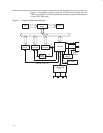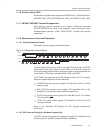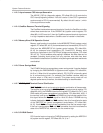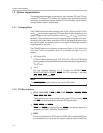
System Features Selection
1-3
PCI445X Device
1.1 System Features Selection
This section explains selectable system features. Feature selection is required
for GPIO and MFUNC terminal assignments and PCI445X register
initialization. Detailed system implementation methods are described in the
following sections. All functions cannot necessarily be used at the same time,
because of the limitations of programmable multifunction terminals (i.e.,
MFUNC7–MFUNC0).
1.1.1 Package Types
The Texas Instruments PCI445X device is offered in two package types:
256-terminal ball grid array (BGA) and 257-terminal MicroStar BGA.
MicroStar BGA is a type of chip scale packaging (CSP).
1.1.2 G_RST and PRST
The PCI445X device has two reset inputs, G_RST and PRST. G_RST resets
all registers and state-machines; PRST
resets registers that are not required
to maintain context in a low power state (see Table A–1 and Table A–2). If the
system does not support a wake-up event from D3-state (hot or cold), then
these terminals can be tied together.
1.1.3 PME and RI Signaling
For supporting a wake-up event, a power management event (PME) and/or
an RI signal should be signaled to the system. PME
is available only on the
RI_OUT/PME terminal. RI_OUT is available on RI_OUT/PME or MFUNC7.
PME and RI_OUT signals are usually connected to the south bridge or
embedded controller (EC). Detailed PME and RI signal behavior is explained
later.
1.1.4 ZV Support
The PCI445X device has internal zoomed video (ZV) buffers. It can support
three ZV sources, from two PC cards and one external source. Refer to the
detailed implementation guide in Section 1.3.2. The PCI445X device has the
ZV autodetect function for supporting a third external zoomed video source.
ZVSTAT and ZVPCLK are required to support the third source. (The ZV
autodetect function needs ZVPCLK for input, and ZVSTAT for enabling.)
ZVSTAT can be assigned on the MFUNC0, MFUNC1, or MFUNC4 terminal.
1.1.5 EEPROM for Subsystem Vendor and Subsystem ID Registers
Subsystem vendor ID and subsystem ID registers (PCI offsets 40h and 42h)
can be loaded from EEPROM through a two-wire serial interface. These
registers can be configured by BIOS if the PCI445X device is implemented on
the motherboard, by setting the SUBSYSRW bit (system control register, PCI
offset 80h, bit 5). EEPROM may be required for docking systems and is
required for add-in cards. The EEPROM interface terminals SDA and SCL are


















